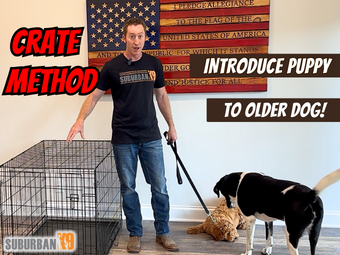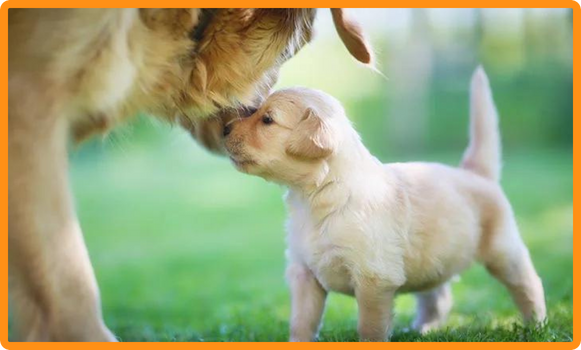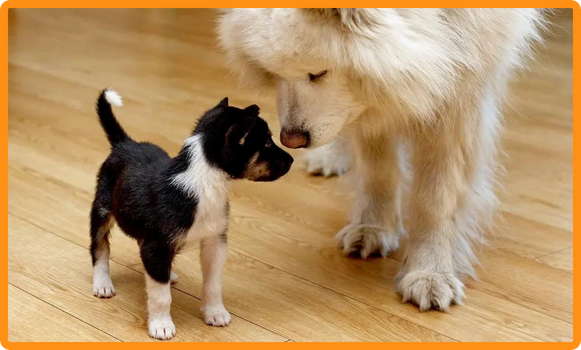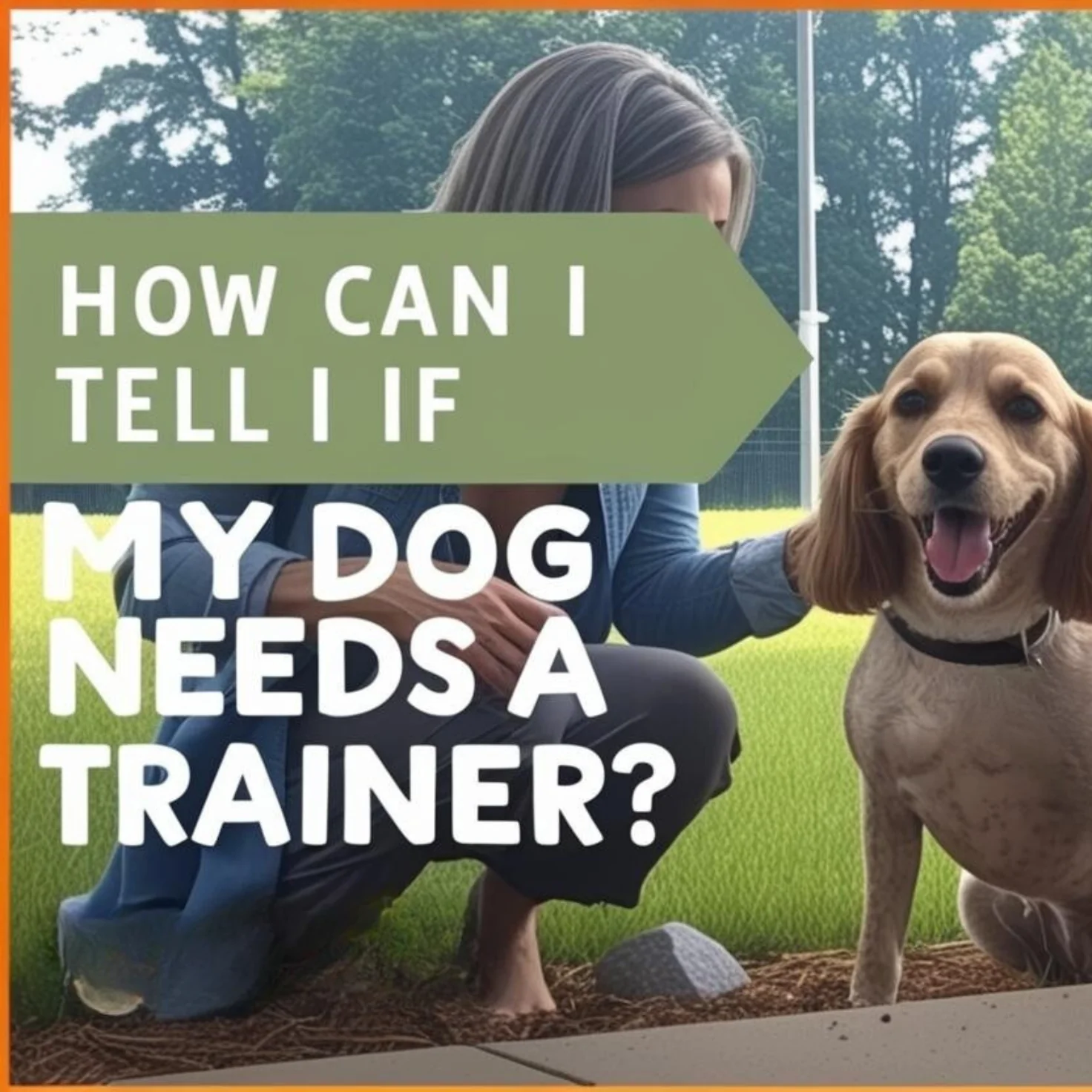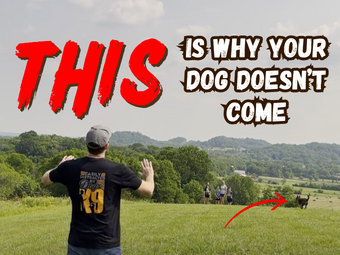How to: Introduce a Puppy to an Older Dog
Introducing your new pup to an older dog (that you have had in your home for years) can be a nerve-wracking experience. With our detailed tips and tricks, it will go easy and turn into a loving relationship. Here is our step-by-step guide to make your puppy's introduction as smooth as possible! We will start with focusing on using crates during the introduction.
Step 1: Using a Crate to Introduce a Puppy to an Older Dog
Start off on your dog introduction by observing each of your dog's body language. It is easy to do this safely using crates for the first interactions. Understanding the dog's body language cues is crucial for predicting how they might react to each other upon meeting. This helps with preventing potential conflicts that could arise by identifying the signs of stress or aggression early on. By paying close attention to their body language, you can tailor the introduction process to ensure it's positive and stress-free for both dogs, laying a solid foundation for a harmonious relationship. For introductions, wire-collapsible crates are ideal.
- Newly enhanced with added security features to keep your pet safe | Slide-bolt door latches Paw Block and locking tips
- iCrate single door dog crate measures 48L x 30W x 33H inches and is suitable for extra-large dog breeds with an adult weight of 90-110 pounds.
- Dog crate includes a divider panel, durable & leak-proof plastic pan, protective rubber feet, carrying handle
- Easy to assemble & portable | Dog crate sets up in seconds with no tools required and conveniently folds flat for travel
- Durable & strong, quality construction creates a secure place for your dog to fulfill their natural instinct to den.
Wallen's (Puppy - Body Language)
1. Sniffing: Using their nose is a fundamental way that dogs gather information about their environment and other dogs. When a dog is sniffing, they learn about the other dog's emotional state and even their intentions. Smelling each other is a crucial step in the meeting process. It shows their curiosity and a willingness to explore a relationship together.
2. Pawed Crate: When a dog paws at it's crate, it can indicate a range of emotions. The most common when working on dog introductions is an excitement or curiosity to interact with the other dog. Showing an eagerness to engage more closely can be a positive sign during introductions.
3. Stand Up, Tail Up: This posture signifies alertness and interest. A dog that stands up with its tail up is paying close attention to its surroundings and any dog's they are interacting with. Observing this behavior helps gauge a dog's mood and level of engagement during the introduction phase. If you see this behavior early in an introduction, make sure to keep a close eye on it.
4. Bark/Growl: Barking or growling can have different meanings. It might express excitement, fear, uncertainty, or even a warning. During introductions, it's essential to listen to these sounds carefully to determine whether they're setting boundaries or signaling discomfort, helping you decide how to proceed safely.
5. Play Bow: This is a clear invitation to play, characterized by a dog stretching its front legs forward while lowering its head and keeping its rear end up. It's a universal sign of playfulness and goodwill among dogs, suggesting the dog is comfortable and looking to engage in friendly interaction.
Sunny (Older Dog - Body Language)
1. Tail Wagging: Tail wagging can convey various emotions, from happiness and excitement to nervousness. Watch the wag's speed and motion closely. A relaxed and wagging tail generally suggests that a dog is friendly and open to having a positive interaction. This is a reassuring behavior for you and your puppy to see during the introduction process. It indicates that the dog feels comfortable and is likely to welcome the puppies presence. A stiff and flicking tail would be a sign that you should be more concerned with your older dog's intentions.
2. Sniffing/Interest: As we have already discussed, sniffing is a dog's way of exploring their environment and gathering information. Showing interest through sniffing indicates curiosity and a willingness to engage with your new puppy. This behavior is a positive sign during dog introductions. It shows your older dog's intention to learn more about the newcomer.
3. Relaxed: You want to see a loose, easy posture. This is often accompanied with a soft, open facial expression and possibly a gently wagging tail. Seeing this signals that the dog feels safe and comfortable with the introduction to the new pup. During introductions between dogs, a relaxed demeanor is an excellent sign!
Step 2 How to Use a Leash to introduce dogs
When moving away from using the crate, leashing one or both of the dogs is important for their initial interactions to be safe. Leashing should be considered a precautionary measure, not necessarily a sign of mistrust, but rather a dog training tool to facilitate a controlled and positive introduction. If there's a high level of trust in one dog's ability to remain calm and not overwhelm or react negatively towards the other, you might choose to leash only the other dog. This approach allows for a bit more freedom for the trusted dog to explore and interact at their own pace while still maintaining control over the situation.
Use the right leash
Make sure you use a sturdy and easy to grip fixed 6 or 8 foot leash. We prefer to use leather leashes exclusively, they are the best combination of comfort and durability. Retractable leashes are poor when it comes to fine control of your dog, and this is a situation where we need the absolute most control.
- REAL GENUINE LEATHER dog training leash is real Italian imported leather, assembled and accomplished in China.
- METAL CLIPS Using pure copper alloy casting, the high quality plating process, outstanding clip appearance
- MILITARY GRADE TRAINING Law enforcement and military grade of professional training.
- CONVENIENT AND COMFORTABLE 5.6ft length let you and your dog in your backyard or walking down the street has become more relaxed
- WARRANTIES SERVICE If you have any problem of these dog leashes, don't hesitate to contact with us.
However, in many cases, especially when any uncertainty exists about how either dog will react, it's wise to keep both dogs leashed. This ensures that each interaction can be closely monitored and managed, preventing any potential mishaps that could arise from unanticipated reactions. It's a balance of trust and caution, emphasizing the safety and well-being of both dogs as they navigate the process of getting acquainted.
Let them meet and evaluate
1. Sniffing Butts: This is a natural behavior in the dog world, serving as a primary means of communication. By sniffing each other's butts, dogs can gather a wealth of information about one another, including health, diet, and their emotional state. It's an excellent form of greeting and getting to know each other.
- Some dogs may be more reserved or uncomfortable with being sniffed during a puppy introduction. This hesitancy indicates that you should take things slower with the introduction. You want the dogs to interact at their own pace, respecting each other's individual comfort level and signals to ensure a positive and stress-free introduction. Having them on leash helps you monitor the interaction and if one dog is coming on too strong, you can quickly slow things down.
- Sudden Movement: Sudden movements during dog introductions are very normal. It is important to watch these carefully, like Matt does in this video, as these movements might trigger a defensive response or excitement.
2. Barks or Growls: Barking and growling can indicate discomfort, fear, or the establishment of personal boundaries. During dog introductions, these sounds can indicate that a dog is setting limits on how close the other dog can get. It's a normal part of the process, but you should monitor it closely to ensure it does not escalate into agression.
3. Pawing: Pawing can signify; playfulness, attention-seeking, or even mild frustration. When a dog paws at another dog, it's important to interpret this behavior along with their body language. It can be a friendly invitation to engage or a way to test the waters in their budding relationship.
Trust between dogs doesn't develop instantly; it builds over time through consistent and positive interactions. Initial introductions don't require complete trust between the dogs but rather a cautious optimism. It's about managing the situation with care and attentiveness to their reactions, gradually fostering a sense of security and mutual respect.
Having trouble? Go for long walk together before meeting
While this requires two handlers instead of one, a favorite technique of our trainers is to simply take the dogs on a walk together. Just a 30 minute walk can help:
1. Build Trust: Building trust between a new puppy and an older dog involves creating a series of positive experiences and interactions between them. This can be achieved through supervised playtime, shared walks, and offering treats simultaneously, ensuring both dogs associate each other's presence with positive outcomes. Consistency and patience are key to develop trust over time and reinforce the idea that the dogs are safe and secure with each other.
2. Get to Know Each Other: The walk allows the dog's to get to know each other without being in each other's face. You've provided them the opportunity to explore each other's scents, behaviors, and body language in a very controlled environment. Interaction should be encouraged but not forced, recognizing and respecting each dog's comfort level and signals. Through gradual exposure and positive reinforcement, dogs can learn about each other's personalities and preferences, forming a solid foundation for their relationship.
3. Calm Them Down: Keeping both the puppy and the older dog calm during their initial meetings is essential for a smooth introduction process. The act of going on a walk together is our favorite technique to calm them down when in the presence of another dog. The goal is to ensure that each interaction ends on a positive note, contributing to a relaxed and trusting relationship between the dogs.
Step 3 How to Teach a Dog Good Manners
1. Correct Too Much Barking: While some vocalization is natural during the introductory phase between dogs, excessive barking should be addressed calmly and firmly. This behavior can escalate tension and lead to a negative interaction. Correcting excessive barking with quick tugs on the leash, and if needed heel the dog away to calm it down and reset.
2. Stepped in When Puppy Cornered: If a puppy finds itself cornered or trapped by the older dog, it's crucial to intervene promptly to prevent fear or defensive aggression from developing. Stepping in to create space and ensure safety helps to maintain a positive environment for both dogs. This intervention should be done calmly and confidently, showing both dogs that you are in control of the situation and that they are safe under your guidance.
3. Older dog correcting: It's natural for older dogs to use vocalizations like a warning growl to set boundaries with a new puppy. These corrections are a part of dog communication, teaching the puppy about appropriate social behavior and limits. A growl can be considered a normal part of their interaction, if it does not escalate further. Monitoring their body language closely during these moments is essential to ensure that both dogs are comfortable and that the older dog's corrections are appropriate and not overly intimidating.
Having Trouble? Reach Out for Professional Help
Navigating this process can sometimes be challenging, and that's where Suburban K9 comes in. If you're seeking to ensure a smooth and successful introduction between your dogs, we invite you to reach out for professional assistance. Our team of expert dog trainers is dedicated to providing the guidance and support you need to create a safe and supportive environment for your dogs to get to know each other at their own pace. With the Suburban K9 Difference, you can build a strong foundation for a lasting bond between your puppy and older dog, enriching the lives of your entire family. Don't hesitate to reach out for an instant free quote and take the first step towards a peaceful and joyful canine relationship.
The article above contains Affiliate Links from Amazon and other companies. If you visit their site and buy the product, we will get a small commission. Please know that we only recommend products we love and would never recommend a product we think is less than great. We look at and try hundreds of products before we ever recommend them to our clients!
